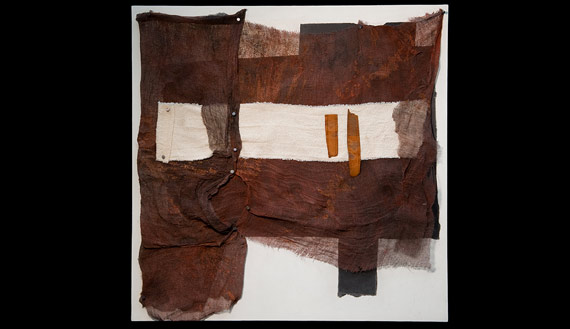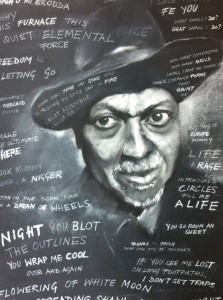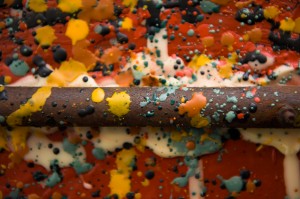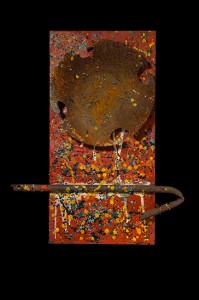July 5th 2019
THE PIPER’S RETURN – ARTIST’S STATEMENT
Populist politicians… charismatic predators… totalitarian dictators… there are a lot of Pipers about.
So the sinister old legend of the Pied Piper feels very contemporary.
The story seems to have originated in medieval times. The Brothers Grimm wrote it up early in the nineteenth century. It runs basically as follows:
Hamelin, a town in Germany, is afflicted by a plague of rats. A stranger in multicoloured (“pied”) clothes arrives. A musician, a Piper with magical powers. He offers to get rid of the rats, for a fee. The town’s authorities hire him. He plays to the rats on his pipe and enchants them, leading them out of town to their destruction.
But when the townsfolk refuse to pay him, his wrath is cataclysmic. He plays to the children of Hamelin, mesmerising them. They follow, dancing happily to their doom. In one version, they drown in the River Weser. In another, they vanish forever – all 130 of them- into the dark cavern of a mountain. In some accounts, three children survive, only because they physically can’t follow the others- one can’t see, one can’t walk, one can’t hear.
The story may have begun with a mysterious event that swept away the children of Hamelin late in the thirteenth century. But what it was, no one knows. The town’s chronicle of 1384 just says: “It’s 100 years since our children left.”
What does it mean? The rats (a later addition to the tale, it seems) evoke the deadly bubonic plagues which black rats were long thought to carry and spread. These plagues ravaged much of Europe in successive waves, the most catastrophic being The Black Death, around 1347-49.
Perhaps the story began as an echo of The Children’s Crusade of around 1212, with its mass hysteria and charismatic leaders: children from Germany and France were said to have set out in their thousands to march to Jerusalem and reclaim the Holy Lands. They never made it. Instead, they ended up dying, drowning or being sold as slaves.
Or, the legend may relate to mass migration of young people from Hamelin, answering a call from foremen from eastern Europe promising work and riches- not so much children, then, as poor teenagers or young adults seduced by the lure of a better life. (Research suggests the names of people and places far to the east of Hamelin bear out this theory). Or this tale of a lost generation could be about the trafficking and rent/sale of children by their poverty-stricken parents.
It’s also been suggested The Piper was a sexual predator, a prototype of the mass paedophile, a Jimmy Savile of the Middle Ages.
The legend is certainly a brutal warning that we would all do well to pay our dues.
It also warns us about the abuse of power by demagogic leaders who prey on the young and gullible.
The ultimate Piper of the twentieth century was Adolf Hitler. He orchestrated the brainwashing of a generation of children and led them to their apocalypse. Hitler and the Nazis sucessfully dehumanised the Jews and other groups in the minds of the young by depicting them as “vermin” to be eradicated like plague rats. It’s a classic demagogue tactic and we are hearing this language again.
In World War Two, Hamelin Prison was used by the Nazi SS to imprison, torture and kill political prisoners. Things came full circle after the war, when British Occupation Forces executed Nazi war criminals in that very same prison. 202 were hanged there by British hangman, Albert Pierrepoint.
Those he hanged included the notorious death-camp guard, Irma Grese, variously known as The Hyena of Auschwitz and The Beast of Belsen. Irma, brought up The Hitler Youth, had wanted to be a nurse . Ten years old when Hitler came to power, she was only 22 when she hanged.
Many of those executed were buried in the prison grounds near the River Weser. Later, their remains were reburied eslewhere. The prison is now a large hotel, where you can stay. There was controversy a few years ago after an entertainment weekend involved people dressing as Nazis. There were some strong protests but it seems the hotel owners were unapologetic.
February 3rd 2017
CAMBODIA: THE LAND OF THE LEPER KING
paintings by Mark Halliley at Pictorem
In Phnom Penh, capital of Cambodia, “tourist sights” include the torture centre S-21, (from the time of Pol Pot’s murderous regime 1975-1979) in the premises of a suburban High School. In the former classrooms now cleaned of all blood and stench, you see row after row of photos of victims: 14-15,000 of them, photographed before they were tortured. Once they had “confessed”, they were dispatched by night in trucks to the countryside nearby. Today’s tourists often follow the same route, to the local Killing Fields execution-site of Choeung Ek. There, you see some 10,000 skulls with cracks and holes in them, piled high in a memorial, some arranged according to the implement used to smash them in- hammers, clubs, farming-tools. They were seldom shot, as firing was noisy, and bullets cost money.
In Cambodia, I also met some very remarkable people who lived through the worst excesses of the rule of Pol Pot. Like the artist Bou Meng, one of the survivors of S-21, spared as he produced a good likeness of Pol Pot. He now bears witness to Cambodia’s holocaust. Or, the teacher and Angkor guide Ponheary Ly, who as a girl survived one of Pol Pot’s murderous slave-labour camps. She now heads an internationally-acclaimed charity (www.theplf.org) that helps the poorest of the poor get an education, from primary school right through to graduation- helping to rebuild Cambodia.
Among the ancient temples of Angkor, is The Terrace of the Leper King: a clay mound, and beneath it, a narrow walkway, lined with row after row of smallish sandstone figures- gods and goddesses, dancers and angels, kings and protectors. Carved some 900 years ago, many are well-preserved. But many are cracked- some, battered and smashed. Some were never finished. All have outlasted mines, bombs, tanks, conquests, invasions, foreign occupation, famine, torture, mass extermination, switches of religion (Hinduism, Buddhism), the rise and fall of empires. They are all lepers, all kings. On top of the mound, is a large replica statue of a figure academics say is Yama, the Lord of Death. Local legend says it’s the Leper King, who ruled despite being consumed by his disease.
In these representational paintings of old carvings, I have tried to express something about survival and memory in modern Cambodia.
Mark Halliley www.markhallileyart.com Feb 1 2017
October 19th 2014

SURVIVORS
LOCATION The Stone Space, 6 Church Lane, Leytonstone E11 1HG Oct 16—26. The gallery is 2 mins from Leytonstone Tube (Central Line)
OPEN Sat 12-5 Sun 12-4 Thurs 2-6 Fri 2-6
CURATORS CreativeBloc at www.thestonespace.wordpress.com
MEANING(S) Rust versus gloss. Real v digital. Form v time. Use v abuse. Finds v losses. Salvage v rejection. Life v death. Memory v oblivion. Beauty v prettiness. Protection v indifference. Survival v all odds.
MATERIALS Used sandpaper. Wrecked shoes. Old bottle-tops. Discarded cardboard. Hardened paint-rollers. Exhausted exhausts. Plus fragments from belongings of late loved ones eg chair of artmaker’s unforgotten brother, paintbox of artmaker’s unforgotten mother.
I put my trust in the materials that confront me because they put me in touch with the unknown
Robert Rauschenberg
March 24th 2014
 This portrait of the poet the late James Berry was auctioned at a fund-raising event held in his honour. I was honoured to meet James when making a film with the writer Malorie Blackman. By then he suffered from advanced dementia. He had come to the UK on the boat after the Windrush, to escape the “barefoot” life that was his future in Jamaica. Much of his work focuses on the experience of being black in Britain. This image of James, based on a photo taken the day we filmed him back in 2005, appears with fragments from some of his poetry- most especially from the collection FRACTURED CIRCLES.
This portrait of the poet the late James Berry was auctioned at a fund-raising event held in his honour. I was honoured to meet James when making a film with the writer Malorie Blackman. By then he suffered from advanced dementia. He had come to the UK on the boat after the Windrush, to escape the “barefoot” life that was his future in Jamaica. Much of his work focuses on the experience of being black in Britain. This image of James, based on a photo taken the day we filmed him back in 2005, appears with fragments from some of his poetry- most especially from the collection FRACTURED CIRCLES.
March 24th 2014
The Book of the Dark
The Book of the Dark, a series of poems by Mark Halliley, has been made into a unique artwork by calligrapher and artist Rosalind Wyatt. See:
www.rosalindwyatt.com/ calligraphy/ the book of the dark
Sample text from The Book of the Dark:
DREAMING
Not dreaming just sleeping not daring to dream
Not dreaming just sleeping but sleep’s not what it seems
Just sleeping not dreaming going nowhere by night
Not dreaming just sleeping curled up far too tight
Not dreaming just sleeping so you can sense shadows move
Just sleeping not dreaming of any kind of love
Not dreaming just sleeping but not resting in peace
Not dreaming just sleeping no fire and no ice
Just sleeping not dreaming of hell or paradise
Not dreaming just sleeping with the brain null and void
Just sleeping not dreaming the sheet over my head
Not dreaming just sleeping the sleep of the dead
Just sleeping not dreaming of laughter or tears
Not dreaming just sleeping for years and years
Just sleeping or just seeming to be lost in sleep
Not dreaming just sleeping without sinking too deep
Just sleeping not dreaming or that’s how it seems
Not dreaming just sleeping not daring to dream
March 24th 2014


PROTECTOR SIX (STRENGTH AND SHIELD) 600 X 300 mixed media on board
I have recently been working with found objects and combining them with encaustic. This is a detail of STRENGTH AND SHIELD from a series called PROTECTORS.
STRENGTH AND SHIELD started with finding what I think is an old hub cap on a skip. The metal bar I dug up. The rest is beeswax either with or without pigment added. Many cultures have favoured having talismanic/ protector images somewhere near the entrance of the home to ward off intruders and ill fortune.
July 24th 2013
YOUR FACE IS AS A BOOK
A commission for the Nightingale Care Home for elderly people in Clapham, YOUR FACE IS AS A BOOK was a drawing project comprising over three dozen portraits in charcoal and chalk, each drawing 75 x 55 cms. The project was completed early in 2013.
I was one of several artists who responded to a call to submission, facilitated through the care home by artist Rosalind Wyatt. My aim was to combine the drawings in some way with the spoken words of the sitters, to give them a voice- and to give the onlooker an idea of the life they had led up to this point.
I was working in a unit where most of the residents are in moderate to advanced stages of dementia. Some could not speak at all, some spoke in fragmented ways, some could sustain more of a structured conversation. Whatever they said, I took it down and wrote it on the drawings. I also drew some of the staff.
This has been a significant experience for me and during it, I have often thought of my own mother, who suffered from dementia towards the end of her life and died in a nursing-home.
Twenty of the portraits have been framed, thanks to an anonymous donor, and have been hung by the Timothy Taylor Gallery at the Nightingale.
Links:
www.nightingale.org.uk for more info on the Nightingale
www.rosalindwyatt.com for Ros Wyatt’s artwork
www.livingwords.org.uk for other work, by Susanna Howard of Living Words, with people who have dementia



